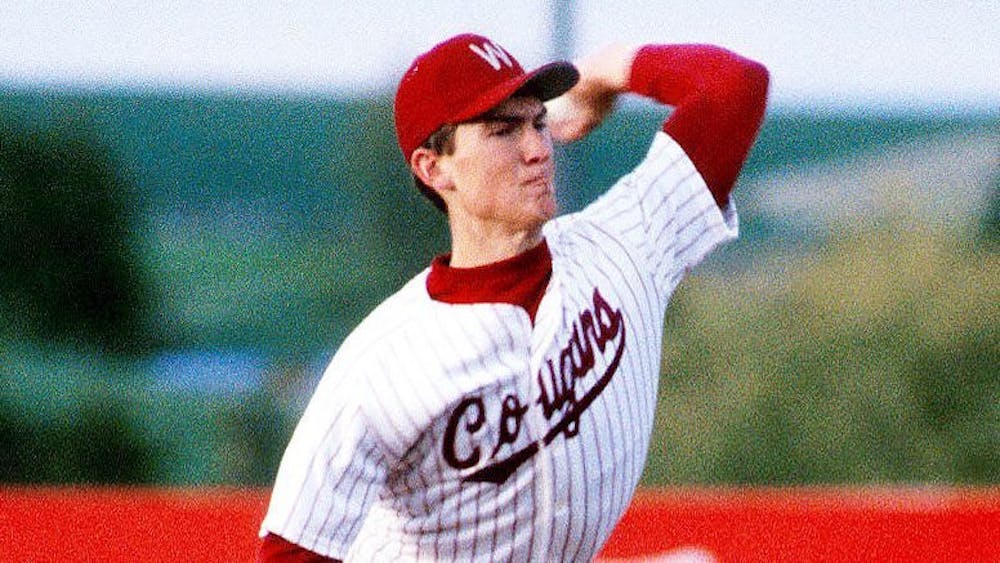“The greatest two-way player in the history of college baseball might never be as acknowledged as he should,” Ryan McGee of ESPN wrote. “But back in Pullman, No. 18 will never be forgotten.”
This quote comes from Theo Lawson of the Spokesman speaking about John Olerud and his time in college. With Shohei Ohtani signing his 10-year, 700-million-dollar contract, the two-way superstar has been one of the best players in the sport due to his excellent hitting and pitching abilities. However, John Olerud’s college numbers as a pitcher, and as a first baseman are mind-boggling when looking at it.
From 1987 to 1989, Olerud played for the Washington State Cougars. From the Washington State Magazine, Olerud as a freshman hit a stellar .414, while also having home runs and 20 RBIs. On top of this, he had a 3.00 earned run average with an impressive eight wins to only two losses. He also was named Baseball America’s Player of the Year. Mind you, this was only as a freshman. Olerud was an 18- and 19-year-old going up against some of the best players in the nation with years of experience, but this was only the beginning of his dominance.
In Olerud’s sophomore year, the accomplishments he had were the greatest of his baseball career. From ESPN, hit a whopping .464 with 23 long balls and 81 runs batted in. He won the Golden Spikes Award, given out to the best college player in the United States. Pitchers could not figure them out. Even with these impressive numbers, these weren’t even the best statistics from his 1988 season. That would come from his reign as a pitcher. While his 2.49 ERA was a big step up from the prior year, he finished the year with 15-0(!!!). He couldn’t lose, he struck out 133 batters and put the baseball world, not just college, on notice. The Cougars had a 52-14 record and got to the West Regional round in the postseason. However, not every story is sunshine and rainbows, and John Olerud had to fight his way through it.
In the offseason, Olerud was running indoors with his teammates before falling to the floor. He was rushed to the hospital and was suffering from a brain hemorrhage. According to ESPN, it was a stroke that was pouring blood down his spine. On second opinion, he had a brain aneurysm just behind the nasal cavity. In February of 1989, Olerud underwent a six-hour brain surgery. He requested that they go through the right side of his brain, so as not to affect his baseball motor skills. He came back to the baseball field in April, where against all odds still put up a very impressive .359 batting average and first-team All-Pac 10 honors as a designated hitter. A true warrior and an inspiration that one can overcome anything. He was drafted in the third round of the MLB Draft.
While never pitching in the bigs, he still put up a very remarkable career. He skipped the minors entirely and made his MLB debut on September 3rd, 1989, according to the Washington State Magazine. In 1992, John Olerud and the Blue Jays won a World Series against the Atlanta Braves. Winning in six games. In 1993, he led the American League in a plethora of stats. From batting average to on-base percentage, to doubles, and more. He also won the Hutch Award, given to the MLB player who best demonstrates the fighting spirit and competitive desire of Fred Hutchinson. He had good stints with the Mets, Mariners, Yankees, and Red Sox before retiring in 2005.
In 2001, he was inducted into the Washington State Athletic Hall of Fame, and later the College Baseball Hall of Fame in 2011 according to the Washington State Magazine. Across his MLB career, he’d accrued a .295 career batting average, 2239 hits, a .398 on-base percentage, and 500 doubles. He also won three gold gloves, two all-star game selections, and two World Series rings. John Olerud was a good pro even with his setbacks and was one of the best college baseball players ever. They also invented the John Olerud Award in 2010, given to the best two-way player in all of college baseball. John Olerud was an amazing player in the sport. Not only because of his play on the field but what he fought off it. An inspiration to people everywhere and he should not be forgotten in time for the sport of baseball.

